Create
Vintage St. Pete: Remembering Dick Bothwell
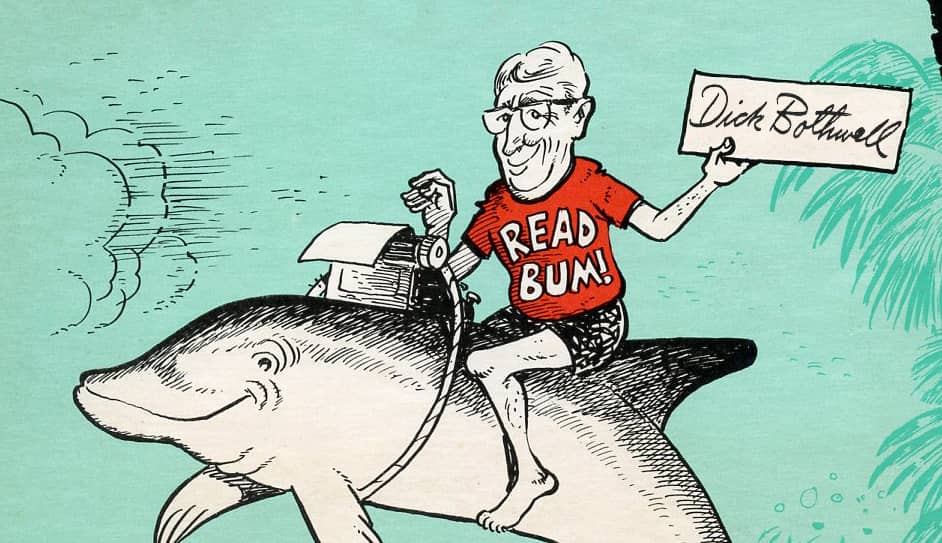
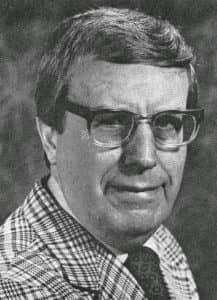 When it was announced that longtime St. Petersburg Times columnist Dick Bothwell had died, uncontrolled weeping reverberated throughout the storied and normally stoic newsroom. The tributes poured in – including hundreds of letters, calls and in-person visits from readers, expressing shock and sorrow that a name and a face they’d known for four decades was, just like that, gone.
When it was announced that longtime St. Petersburg Times columnist Dick Bothwell had died, uncontrolled weeping reverberated throughout the storied and normally stoic newsroom. The tributes poured in – including hundreds of letters, calls and in-person visits from readers, expressing shock and sorrow that a name and a face they’d known for four decades was, just like that, gone.
Although the newspaper wouldn’t start to call itself the Tampa Bay Times for another 31 years, Bothwell’s death on Jan. 30, 1981 was another in a series of signs that St. Petersburg’s identity was changing. The innocence of the early decades was gone. The Sunshine Skyway Bridge had recently fallen – the area’s first real tragedy. Webb’s City, the gargantuan drugstore that had dominated downtown since the ‘30s, was closed and soon to be demolished. The crumbling Vinoy Park Hotel was populated with pigeons, rats and vagrants. And Nelson Poynter, the newspaper’s owner and very public figurehead, a community booster, had died in 1978.
“For many of our readers, Dick Bothwell WAS the St. Petersburg Times,” executive editor Robert Haiman said at the time.
Bothwell was a humorist whose folksy, Will Rogers-esque musings appeared in two regular columns, Of All Things (he called it OAT) and Brighten Up Mondays (a.k.a. BUM). Think Lewis Grizzard without the Southern cutesiness, or Dave Barry without the snark. Carl Hiaasen without the politics.
He wrote about Everyman, Everywoman and Everykid.
He was also a features writer, which meant he interviewed film and TV stars, lady wrestlers, comedians and circus acts, and reported on public events like park and pier dedications, the Festival of States, the Mutt Derby and the charity Fishathon. And a serious student of local history, which he wrote about with relish (and sometimes with mustard), always with tongue planted firmly in cheek.
Author and Poynter Institute writing coach Roy Peter Clark points out that the “dominant columnist” with a distinctive voice was a thing of great value in 20th century media. “Bothwell would never be that today,” Clark says. “Or 20 years ago, even.
“But for the 1940s and ‘50s, and even into the ‘60s, he represented an era of life in St. Petersburg. Which, to the outside world, could be laughed at, as the city of the newly-wed and nearly-dead. As the world’s largest open-air mausoleum.”
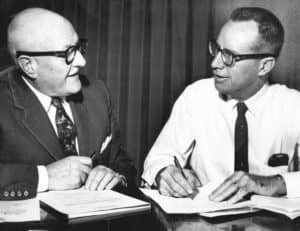
They weren’t all fascinating interviews, but Bothwell the reporter was always game: Here, he talks to banker CRF Wickenden about the Times’ new pension plan for 1958. “But how will the dollar look by 1982, when I will be able (but unwilling) to retire?” Bothwell wrote. Tampa Bay Times/Zuma Press.
However, Clark adds, “inside that world there were people coming here to retire, to leave the cold weather and crime-ridden cities behind … Dick was a Midwesterner, and St. Petersburg was a Midwestern town.”
He knew his readers, and his readers got to know him.
Former Times writer Jeff Klinkenberg remembers Bothwell as “the last of his kind, a corny humorist and columnist who wrote every day, typing his stories with two fingers. He was of the front page era but without the alcohol, cigarettes, the swearing or dizzy blonds.”
Like Clark, Klinkenberg joined the writing staff of “Florida’s Best Newspaper” a few years before Bothwell’s untimely exit at age 63. “He was loved by readers and his colleagues, whom he enjoyed teasing without mercy,” Klinkenberg says. “In addition to his column, he also covered the daily weather under the byline Kcid Llewhtob, his name backwards — unimaginable by today’s journalism standards.”
Little change was in view through Sunday for Florida, but J. Thundersquall Drip, cheerful, corpulent Times oracle, had high praise for the situation. “Who wants to spent a shivery, chill, cold Fourth of July?” he asked. “Who would enjoy sleeping under blankets, picnicking around a roaring bonfire? Nobody, that’s who!”
July 3, 1975
Klinkenberg’s own “Florida road stories” – the humorous and poignant pieces that made him justifiably famous – ended with his retirement in 2014.
In a lengthy, loving 1981 tribute, Bothwell’s friend Bob Stiff, editor of the afternoon Evening Independent paper, had mused that perhaps Bothwell’s old-school, molasses-slow humor made him something of an anachronism, particularly in a fast-paced contemporary newsroom.
“The young people didn’t understand this man without a shred of sophistication, this man who wrote and told corny jokes, this man who never had a bad word to say about anyone, this man who always smiled and never seemed depressed,” Stiff wrote. “They didn’t understand his love for horehound drops, or his dislike for asparagus, either.”
(“That flabby green weed,” Bothwell called it. “At last week’s United Way dinner, the Bayfront Concourse had the bad taste to serve the stuff. There it lay, three limp, flaccid lengths of it, on a bed of lettuce. As an extreme courtesy, I ate it down, the United Way. Talk about giving”).

Born in 1917, James Richard Bothwell grew up on his parents’ homestead in tiny Alva, Wyoming – his father ran the general store – and then in nearby Lead, South Dakota, in the fabled Black Hills.
In 1939, with only a high school education, he answered an ad in Time magazine (a service many national publications provided after the Great Depression). Down in Florida, a place he’d only peripherally heard of, the St. Petersburg Times was looking for an editorial cartoonist.
As it happened, Bothwell’s portfolio was impressive, and he was hired at $17.50 a week, for the Times’ art department. For years, he constituted the entire department.
After a stint in the Army, he returned to St. Pete. That’s when he began writing – first about the weather (sometimes as J. Thundersquall Drip) and, over time, about whatever struck his fancy.
St. Petersburg doesn’t worry about growing older. It worries about growing younger, and even talks hysterically about buying itself a bikini, just to show folks.
Of All Things/Nov. 23, 1962
Local lad has a sure-fire experience for “I’ve Got a Secret,” if it’s still on TV 20 years from now. “I fell off an elephant when I was 20 months old,” he can tell the panel. Happened at Tampa’s Lowry Park (Fairyland Divisions) Sunday afternoon. The idea is, kids pose atop this young elephant, by climbing up a ladder on one side. A chimp poses too, sitting on the elephant’s head.
Of All Things/Jan. 26, 1967
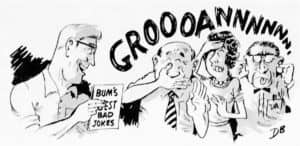
Without fail, his columns ended with some groan-inducing joke. Bothwell regularly received jokes in the mail from readers, and proudly stole from the best (and almost always gave credit where it was due).
How did the pig get to the top of the Empire State Building? Simple. The swine flew.
It was so cold when I was born, I was delivered by a penguin instead of a stork.
Know what you get when you cross a black widow spider and a horse? I don’t either, but if it bites you, you can always ride it to the hospital.
Bothwell and his wife June bought their first St. Pete home on the south side, adjacent to Lake Maggiore. In the days before the county employed professional trappers to capture and kill nuisance alligators, average citizens caught the reptiles, drove to the 327-acre site and released them (and no, it didn’t always work out so well).
Bothwell, as was his nature, was curious about the animals that lived in his back yard. So he researched, and he learned, and he wrote columns about alligators. In 1962, through the Times-owned Great Outdoors Publishing Co., he wrote and illustrated The Great Outdoors Book of Alligators and Other Crocodilia.

Although much of its information is now outdated, particularly in the area of wildlife law, for decades the book was one of the world’s most popular on the subject of Florida’s toothy aquatic lizards.
The newspaper published Bothwell’s second book, Sunrise 200, to celebrate America’s Bicentennial in 1976. Subtitled A Lively Look at St. Petersburg’s Past, it contained more than 40 short essays about various moments in local history. The illustrations were by Times artist Jack Barrett.
Bespectacled, tall and gawky even into his 60s, the toupee-sporting columnist liked to say he was often mistaken for actor Robert Redford, and for emphasis would replace his own OAT photo with that of the handsome Hollywood star.
Just like Orson Wells, I will tell no joke before its time, and a good many after. But in truth, there is no such thing as a bad joke. This rumor was started ages ago by people who could not think of their own jokes.
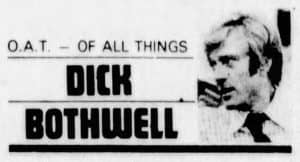
Of All Things/Nov. 12, 1979
On the occasion of his 40th anniversary with the paper, Bothwell was uncharacteristically serious: “I’ve written about all sorts of characters,” he wrote, “but the person I like to write about the most is an older person who has done something with their later years. I feel this is a terrific inspiration to all the older people who think that their useful days are gone.”
Although Bothwell was well-known as the office jokester, engaging in near-constant battles of wits (or half-wits, as the case may be) with other figures in the newsroom, Clark says he could take as good as he gave.
“I guess there are people who are beloved, like the Queen of England, that you don’t want to make too many jokes about,” he says. “Bothwell was beloved in a way that you always wanted to make jokes with him, or about him.”
To illustrate a column he’d written about cowboys, cattle and life in frontier towns, Bothwell wore a full complement of western regalia to work the afternoon of Thursday, July 29, 1981. After a studio session with staff photographer Tony Lopez, he entertained his fellow journalists with a few clumsily-executed rope tricks and a handful of bad jokes.
Friday morning, he woke up with chest pains. A devout Christian Scientist, Bothwell refused to consult a doctor. He sat down in his favorite living room chair, suffered a massive heart attack, and was gone.
Sports editor Hubert Mizell wrote an epitaph for Bothwell: “Newspapers are, by necessity, tough places. Every day, there are stories of pain, bleeding, calamity and death. People have jobs doing nothing but writing about people who have died. But on Friday there was an air around our shop that I had not sensed in 23 years in the business.
“Difficult, but a tribute to the man.”
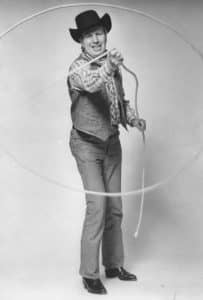
Jan. 29, 1981: To illustrate a story he’d written about life on the fronter, Bothwell – who’d grown up the son of homesteaders in rural Wyoming and South Dakota – wore a cowboy outfit to work. He died at home the next morning (the column was published posthumously). Tampa Bay Times photo by Tony Lopez/ZUMA Press.








Jim Burns
April 14, 2023at12:05 pm
For some reason Dick Bothwell’s name popped into my head today and I found your story. Thanks for bringing back a bunch of memories.
John Avery
September 24, 2022at5:12 pm
Thanks for the memories. When I was a student at Meadowlawn Junior High in 1967 Dick did a story on “New Math” about our teacher and students participating in the School Mathmatics Study Group (SMSG). I think he called it “Some Math Some Garbage” in his OAT column. I was just a teen but I read his column everyday.